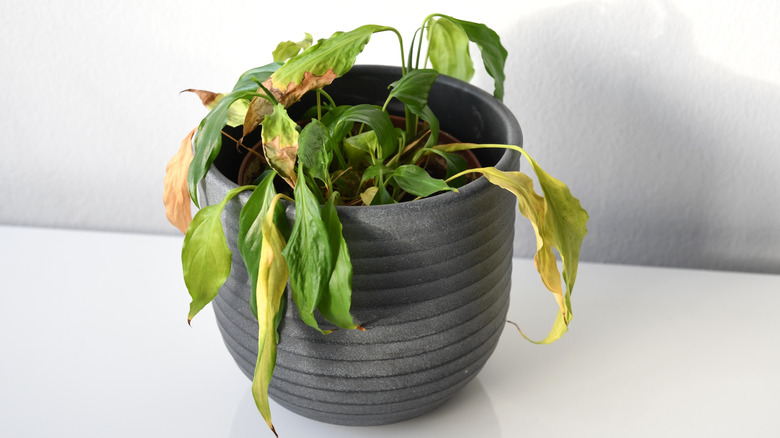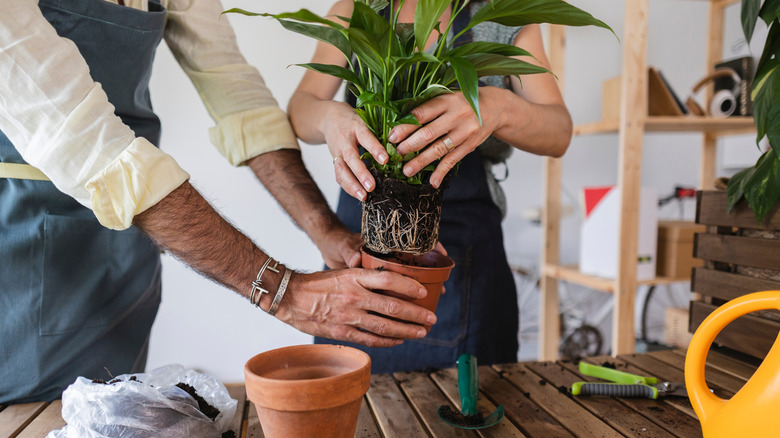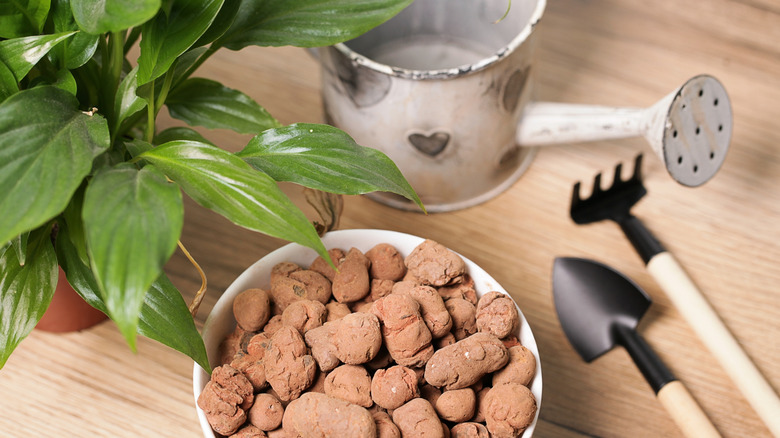Exactly What To Do When Your Peace Lily Won't Grow
Peace lilies are known as drama queens for a valid reason –- they are not shy of drooping their leaves to convey their need for attention and care. However, if you begin to see symptoms like a complete lack of growth, it might be a tell-tale sign that your peace lily is in trouble, not just throwing tantrums. Most of the time, stunted growth happens in peace lilies because of a problem with the roots, or due to a lack of essential resources, like sunlight. The best thing you can do when your peace lily stops sprouting new leaves and flowers is to either repot the plant to a bigger pot or increase its sunlight intake.
Peace lilies (Spathiphyllum spp.) are perennial herbs that like growing in shade and can reach up to 3 feet in height when grown indoors. However, being root bound can easily stop them from growing to their full potential, particularly when you're growing peace lilies as houseplants. If you can see roots emerging from the drainage holes of the pot or even from the surface of the soil, you should definitely consider repotting your plant. Despite peace lilies being favorable to some crowding, the plant can suffer from severe lack of nutrient absorption when its roots are tangled up together.
Peace lilies also perform their best under bright, indirect light. One of the other major reasons for its lack of growth could be that the plant is not getting its fair share of light. Moving your peace lily to an east-facing window that receives ample filtered sunlight could also rejuvenate the plant, if sunlight is the issue.
How to tell if your peace lily needs repotting to grow
Although spring is the ideal time for repotting, you should not wait if you see visible signs of your peace lily struggling to grow. Apart from lack of expansion and absence of new leaves and flowers, other factors like yellowing of leaves, a droopy appearance, or crumbly soil are also good indicators that your plant has outgrown its pot. Once the roots start growing too big for the pot, they begin to strangle the soil and make it more compact. If the soil in your pot seems devoid of nutrients and crumbly, your peace lily definitely needs a relocation. This condition also becomes evident when you water your plants and the soil seems unable to retain any of it. This happens due to excessive soil compaction and is detrimental to healthy plant growth.
Repotting your peace lily promptly would also ensure that the plant stays away from the evils of root rot –- another dreaded condition that hinders plant growth. Root rot sets in peace lilies when the pots do not allow efficient drainage. This becomes evident when its leaves begin to turn yellow. As soon as you see this symptom, take your houseplant out of the pot, inspect the roots, cut out any that are rotting, and shift the plant to a bigger pot. When choosing the size of this bigger pot, make sure that it is not more than a couple of inches larger in diameter than the previous one.
How to repot your peace lily (& how to care for it afterwards)
Once you have selected the right size of pot suitable for growing the plant, put about an inch of well-draining potting mix at the base of the pot. Gently remove your plant from its container so as to not damage it, and give it a light shake to loosen up the roots and get rid of any soil. Then comes the crucial part of inspecting the roots for signs of damage, rotting, or pests. Get rid of any damaged portion and wash the roots at room temperature. Place the plant in the new pot and fill it with soil to just a few inches below the rim. You can also make use of gravels to help your peace lily plants flourish in optimum humid conditions.
Your job as a gardener is not done after repotting. To make sure that your plant does not suffer from transplant shock, you need to ensure that it receives proper care afterwards as well. Do not put the houseplant in direct sunlight immediately after repotting. Refrain from using any fertilizer for at least six weeks to give the plant ample time to adapt.
When it comes to watering, although you need to give your peace lily a fair gulp after transplanting, come back to a weekly watering schedule afterwards. You should also water the plant the night before the transplant to make the transition smoother. To avoid overwatering your repotted plant, always inspect the top few inches of soil to gauge moisture levels before you give the plant a drink. At the same time, dead stem tips and wilted leaves are some of the signs you could be underwatering your peace lily plant.


